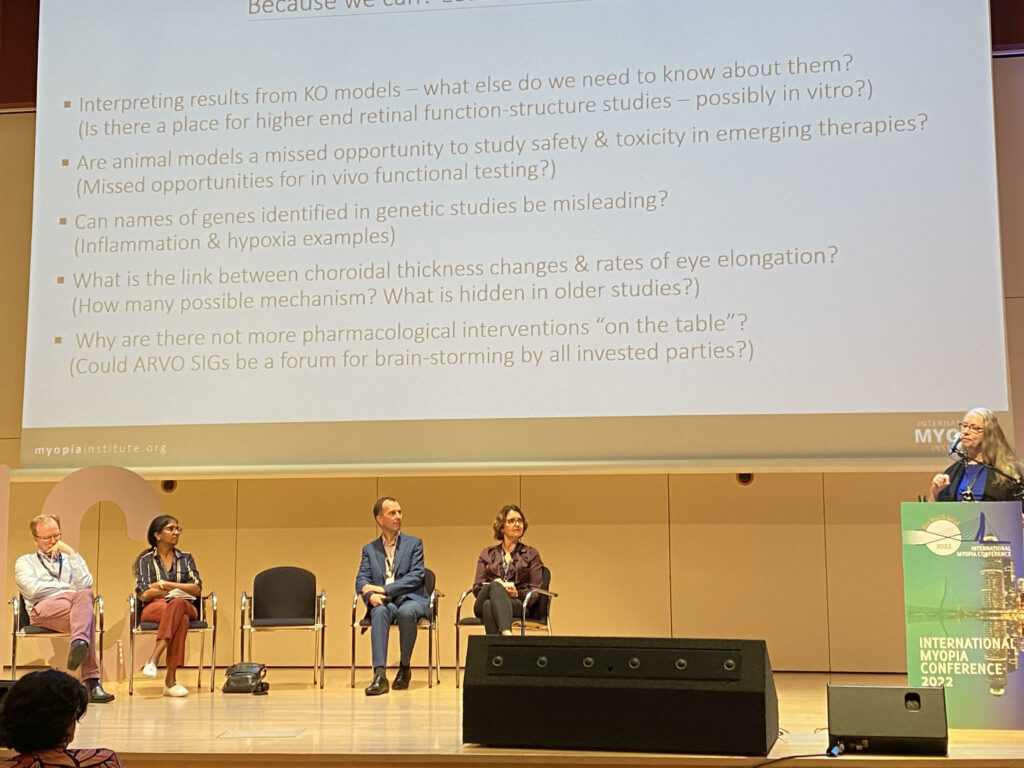IMI at the International Myopia Conference 2022, Rotterdam.
The IMC conference held 4-7th September, Rotterdam, Netherlands attracted over 700 clinicians and researchers from around the globe. The conference sessions and posters covered an expansive range of topics including myopia prevalence in different parts of the word, experimental and animal models, management strategies, imaging and biometry, risk profiles, complications, genetics and public health.
The conference ended with a lively IMI debate session chaired by IMI’s chief scientist Professor James Wolffsohn and included a panel of IMI’s leading scientists including Professors Ian Flitcroft, Christine Wildsoet, Padmaja Sankaridurg and the conference host Caroline Klaver. Professor Wolffsohn provided a glimpse into the next IMI white paper series to be released in early 2023 and together with the panellists provided an overview of key take home messages from the conference. See below for some of the conference highlights presented by our panel.
The IMI panel presentations were followed by lively audience participation on unresolved areas in relation to outdoor time and the role of the choroid in myopia development. Professor Wolffsohn noted “it was great to opportunity to reflect at the end of some intense days of new findings and challenging theories, with the audience fully engaged in the debate.”
Here are some interesting highlights from the sessions as summarised from our panellists and our IMI program director Dr Nina Tahhan:
Myopia around the world – IMC conference session summary by Dr Nina Tahhan, IMI Program Director
At IMC, we heard from our IMI travel award winner Patricia Ioschpe Gus from Brasil that there has not been much research on the prevalence of myopia in her country. She conducted a multi-centre study in 330 schools and found myopia prevalence 17% and high myopia 2.1%. The risk was higher in females and each additional hour of screen time per day increased the chance of myopia by 6.5%. The last prevalence study conducted decades ago in Brazil reported a 9% prevalence. Hence, we see a rise in prevalence occurring as has been report in other parts of the world.
Eva Lazuka-Nicoulaud identified that children with uncorrected myopia in Kosovo were more impacted with learning, were squinting, sitting closer to the board and more socially frustrated.
Rakhee Shah demonstrated that there was an increase in myopia post-covid in the UK in 4–5-year-olds.
We heard from our host Professor Caroline Klaver about the generation R study in the Netherlands; 28% of Dutch children were myopic by 17 years of age, it is more common in females, more common in non-Europeans than native Dutch and those with lower socio-economic status at greater risk.
Leila Eppenberger discussed the rate of myopia in Swiss military recruits – this appears to be unchanged between 2008 – 2017 in 18–25-year-old males.
Tim Fricke challenged us in our thinking about how to analyse and monitor population-level data. Simply reporting mean and standard deviation of data can be an inadequate method due to the skew and kurtosis we see in refractive error data on a population level. It is also challenging to compare different studies when they use different refractive cut-points. Tim describes a novel way to describe population data which can overcome some of those obstacles. He shows us how mixing together 3 symmetric distributions can more accurately describe refractive error population data.
This session was ended by some more challenging thoughts from Professor Ian Morgan who suggests that the default for emmetropization is not moving to emmetropia, it is a preference for slight hyperopia. His belief is that emmetropization doesn’t reflect refractive development – creating a hyperopic reserve is the tendency and hence we should consider myopia control with pre-myopia. Some of the audience, including our panelist professor Ian Flitcroft, commented that it might appear this way under cycloplegia, but the natural state refractive error tends towards the range of an emmetropic refraction! Food for thought!
Public health – summary take home messages from Professor Ian Flitcroft and Dr Nina Tahhan
Huge cohort of aging myopes
- Simulation of progression trajectories of myopia from childhood to older life in China shows pathological myopia will be the next public health challenge as the current generation of children age
Inadequacy of treatments
- More than one third of the high myopic patients with myopic macular neovascularization (MNV) develop a MNV in the fellow eye within 10 years. Younger people are at greater risk for bilateral MNV
Predictive factors of visual loss (anisometropia vs mechanics vs background genetics)
- Patients with high axial anisometropia with pathological myopia in the longer eye should be monitored carefully for complications of pathology in the shorter eye.
- Hypothesis, that ocular axial elongation is associated with epidermal growth factor (EGF), and that further axial elongation may be prevented by an EGF blockade e.g., panitumumab
- Macula curvature changes may serve as a biomarker for highly myopic eyes at risk of developing other pathologies
Public health problems need public health solutions
- Intervention for changing the classroom environment evaluated in China. Natural classrooms were installed with custom-made wallpaper with forest and sky scenes with comparable spatial frequency spectra as natural outdoor environment. This was compared to the traditional classroom setting of a white wall. Natural classroom was favoured by both the teachers and students. Efficacy data will follow
Ophthalmology vs Optometry vs Telemedicine
- Insights from patient experiences (high myopia patient organisation) urge professionals to unite for myopia control and patient management due to multi-dimensional aspects/co-morbidities and unclear, mixed messages that can come too late
- Remote eye-testing – children and parents able and willing to perform remote tests – a promising avenue to achieve universal access to eye care
Experimental and animal models – IMC conference insights from Professor Christine Wildsoet, UC Berkley
What have we learnt new or that has up ended our ‘beliefs”?
- Many cell types in the retina appear to be involved in eye growth regulation & myopia
(including L-opsin containing photoreceptors, on-bipolar cells, A-type horizonal cells - Age of exposure to myopia-inducing stimuli matter, at least in guinea pig
(early age of exposure results in higher myopia) - Zebrafish are a potentially powerful model for studying genetics
(identifying candidate genes using mutant strains) - Naturally occurring myopia in guinea pigs may also provide new insights into key genes & regulatory pathways (albino example)
- Scleral cross-linking seems a logical treatment to explore for myopia control BUT at what cost – GLAUCOMA?
- Polarized OCT imaging allows scleral collagen organization to be studied in vivo!
- Interpreting results from knock-out models – what else do we need to know about them?
(Is there a place for higher end retinal function-structure studies – possibly in vitro?) - Are animal models a missed opportunity to study safety & toxicity in emerging therapies?
(Missed opportunities for in vivo functional testing?) - Can names of genes identified in genetic studies be misleading?
(Inflammation & hypoxia examples) - What is the link between choroidal thickness changes & rates of eye elongation?
(How many possible mechanism? What is hidden in older studies?) - Why are there not more pharmacological interventions “on the table”?
(Could ARVO SIGs be a forum for brain-storming by all invested parties?)
Optical Interventions and combination therapies – IMC lessons learnt by Professor Padmaja Sankaridurg, Brien Holden Vision Institute, Sydney, Australia
- Spectacle and contact lens interventions to slow progression in “myopic eyes” are gathering pace
- Many industry led innovations- rationale behind non co-axial, halo reducing contact lenses from Johnson and Johnson, efficacy data for Stellest demonstrating slowing of myopia of nearly 1D over 3 years, 1 year clinical trial efficacy of Sight Glass DOT glasses, efficacy of novel peripheral defocus image inducing spectacles
- For most interventions, it is difficult to determine superiority due to the wide confidence intervals in treatment effect data and differences in control groups between trials. However, 0.01% Atropine and centre-distance +1.50 Add multifocal lenses show less effect than other treatments (Gifford P and Gifford K).
- Orthokeratology – evidence smaller treatment zones have better myopia control efficacy.
- Need to further focus efforts on:
– Understanding and improving efficacy- treatment effect in fast vs slow progressors, responders, reversal of eye growth, peripheral refractive errors- uniform change in peripheral refractive error profile with DIMS test group.
– Use of appropriate control arm in clinical trials; use of age matched controls including virtual controls
– Still need agreement on appropriate metric to define efficacy- percentage reduction, absolute treatment effect, physiological growth:
- Choroidal thickening? BLINK study did not find significant changes
- Visual performance affected with novel treatments- peripheral vision, contrast sensitivity reduced but not significantly.
- No data presented on combination therapies. Poster (Nilsen Nikolai et al) -1% Topical Atropine did not alter diurnal rhythm but affected the phase and amplitude of the rhythm of ocular components.
Genetics and complications – key messages from Professor Caroline Klaver

The in depth analysis of genetic findings will tech us more about the pathways involved in Myopia. Genetic analysis for Myopia in the clinic will not become a routine procedure.

Myopic complications, visual impairment and blindness are the main drivers for our science. More matchmaking between science and clinics is needed.
Imaging, biometry, near work and risk profiles – take home messages by Professor James Wolffsohn
Imaging and biometry
- Need to consider Axial Length & Rx separately
- Retinal thickness used to diagnose glaucoma in myopes
- High myopia associated with reduced disc thickness except temporally
- Potential of phase sensitive OCT
- Myopic defocus in superior retina Þ higher myopia progression
- Age of myopia and degree affect progression
- Deep learning system identifies ‘at risk’ children
- Ultrawide OCT + triple input polarized OCT can be myopia biomarkers
- mfERG not associated with peripheral refraction
- Development of quantitative ultrasound for evaluating scleral microstructure
- Myopes faster On-pathway activity linked to severity (opposite to what was found previously)!
Myopia management strategies
- Rise of myopia spectacle prescribing globally and turning point on single vision prescribing as now decreasing for progressing myopes
- Barriers to myopia control implementation in China
- How do we accurately describe relative treatment effect?
- Future techniques needed to avoid control group ethical challenge
- Anti-myopia treatments at Denmark Uni Hospital discussed
Risk profiles
- Myopes have longer eyes which increase, but what about adults?
- Lux on retina affected by axial length – mechanistic?
- MyoMatch approach as good as modelling for progressing myopia
- Eye growth continues beyond age 10, so when to stop treatment?
- Late chronotype (night owl sleeping pattern) associated with myopia
- Increased screen time associated with myopia, astigmatism + BMI
- Monocular near accommodative facility reduced after 1hr PC time


